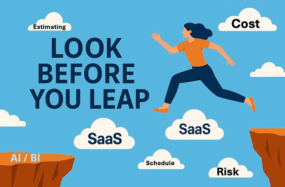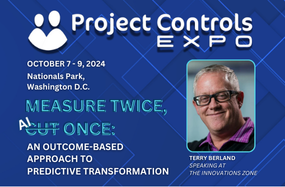
Finding Meaning in the Metrics: 6 Ways Project Controls Teams Can Prove Their Value

At the 2025 Project Controls Expos in Washington, D.C. and London, one theme came through loud and clear: project controls teams are drowning in data but starving for insight.
Every project generates mountains of metrics — cost, schedule, risk, quality, safety, and ESG — yet many teams struggle to translate all that information into something the business can act upon. The result? Tremendous effort, limited recognition, and too often, slow or suboptimal decisions.
The problem isn’t the lack of data — it’s the lack of connection. Too many systems, too many spreadsheets, too many silos. That’s where the Unified Project Platform (UPP) model comes in.
A UPP solves this exact challenge: to connect every project system, application, and dataset in a secure, cloud-based ecosystem that transforms information into real-time, business-ready insight.
The most effective project controls teams aren’t just data collectors; they’re interpreters and communicators. They work within unified environments, not disconnected ones. The UPP makes that possible.
Here are six practical ways to find meaning in the metrics — and prove your value across every project and programme.
1. Align on What Matters First
Before building dashboards or running reports, start with alignment.
Meet early with project sponsors, managers, and functional leads to define what “success” actually looks like. For some projects, it’s cost control or schedule adherence. For others, it’s risk mitigation, ESG compliance, or on-time delivery of milestones.
Agree on five to seven key performance indicators (KPIs) that directly reflect those goals. Revisit them quarterly. Projects evolve, and so should the metrics that guide them.
Within a Unified Project Platform, those KPIs can be pulled from multiple systems automatically — cost tools, schedules, risk registers — giving everyone a single, consistent source of truth.
Once alignment is clear, focus on presenting only the data that supports those priorities.
2. Focus on the Few — Not the Flood
A dashboard with 50 charts might look impressive — but it’s exhausting to interpret.
Every visual should answer a specific business question. If it doesn’t, remove it. Highlight leading indicators that predict outcomes, not lagging ones that simply describe history.
Standardise dashboard layouts across all projects, so executives and project managers see familiar views no matter which project they’re reviewing. Within a BI in the cloud or business intelligence cloud service, that consistency builds confidence and speeds up decision-making.
The UPP takes this one step further: it unifies every system feeding your BI environment, eliminating redundant visuals, duplicate data, and inconsistent logic. When project data is harmonised through the platform, your dashboards stop being cluttered pictures — and start being powerful decision tools.
With the right data in focus, the next step is ensuring your audience actually understands it.
3. Teach Before You Tweak
Dashboards only create value when people know how to interpret them.
Run short sessions for project managers and stakeholders explaining what each KPI means and how it connects to project goals. Add short narrative summaries or tooltips that answer the “so what?” question for each key metric.
Pair every monthly report with a 15-minute insight review call to translate data into discussion.
When teams work within a Unified Project Platform, these learning moments become even more impactful — because everyone sees the same data, from the same source, in the same format. That shared understanding builds trust, clarity, and accountability.
Understanding is only useful if the information stays current and reliable.
4. Keep It Live with Continuous Data Transformation
Outdated or manually compiled data undermines credibility — and decision speed.
The answer is automation. A Unified Project Platform automates data transformation, refreshing and aligning information across cost, schedule, risk, and design systems in near real time.
By eliminating disparate data sources, project controls teams spend less time reconciling and more time analysing.
Work with your data team or a trusted partner to set up automated refreshes that keep dashboards live, ensuring leaders always see the latest project truth — not last week’s guess.
LoadSpring INSIGHTS, for example, continuously transforms and synchronizes project information from every connected system, ensuring every metric reflects what’s happening now. You can read about how one of our customers, BAM UK & Ireland, leveraged INSIGHTS to prepare their data for more useful reporting.
LoadSpring INSIGHTS continuously transforms and refreshes information from every project system—so your dashboards always reflect what’s happening now, not last week.
Learn more about LoadSpring INSIGHTS
5. Leverage AI
AI is transforming how project teams explore and understand data.
Instead of sifting through dashboards, users can now ask natural-language questions and get contextual answers instantly. For example:
- “Which work packages are at the highest risk of delay?”
- “What’s the cost variance trend this month?”
- “Which contractors are performing above target on productivity?”
Related Reading: Just Ask and AI Delivers—The Beauty of Custom LLMs
Tools like LoadSpring’s Elsie AI, integrated within the UPP, allow secure, role-based data queries across the project portfolio. Elsie transforms complex datasets into concise, human-readable insights — perfect for leadership briefings and quick project stand-ups.
This is AI reporting in action: shifting from visualisation to understanding. It’s where the UPP’s unified data model becomes the foundation for AI-powered dashboards that explain what’s happening — and why — in real time.
Start small. Identify a few high-value project questions and enable secure, role-based access for users to query data directly. Pilot it with one project before scaling. Once proven, scale it across programmes.
With live, AI-accessible data, project controls can now focus on communicating insight and proving value across the organisation.
With LoadSpring Elsie AI, teams can ask questions about their projects and get instant answers. Discover Elsie AI →
6. Communicate Value and Close the Loop
Even the best data means nothing if it doesn’t drive action.
Your role as a project controls professional isn’t to deliver numbers — it’s to deliver meaning. Translate data into stories: what changed, why it matters, and what comes next.
Shift monthly reports from static data dumps to decision-driven conversations. Use consistent visuals, terms, and messaging across every update.
Within the Unified Project Platform, this communication loop becomes seamless — insight moves from data to dashboard to dialogue, all within one ecosystem. Over time, that consistency strengthens your credibility and elevates project controls from a reporting function to a strategic enabler.
My Closing Thought
Project controls has evolved beyond spreadsheets and dashboards. It’s now the nerve centre of data-driven project performance.
When teams operate within a Unified Project Platform — aligning with project goals, focusing on the KPIs that matter most, helping stakeholders interpret data, and applying automation and AI to keep insights live — they transform their role entirely.
They stop being the keepers of numbers.
They become the translators of success.
That’s how project controls proves its value — by helping the business achieve outcomes, not just measure them.
See how project controls teams are using unified data to move faster and prove their value. Talk with a LoadSpring expert today.
What is BI in cloud computing?
BI in cloud computing (or BI in the cloud) refers to business intelligence tools and platforms that are hosted in the cloud rather than on-premises. They allow organizations to analyze and visualize data stored and processed over the internet, offering scalability, flexibility, and faster deployment.
What is a BI connector?
A BI connector is a tool or component that links a BI platform or dashboard to various data sources (such as databases, apps, or SaaS tools). It enables the BI system to access, pull, or stream data from those sources for analysis or visualization.
What is an AI-powered dashboard?
An AI-powered dashboard is a dashboard enhanced by artificial intelligence or machine learning. It can automatically analyze data patterns, generate predictions or insights, and let users interact through natural-language queries. Some newer dashboards also use generativeAI to create visualizations, summaries, or explanations based on the underlying data.
Can AI generate reports?
Yes — AI can generate reports. AI-based reporting tools can analyze raw data, identify trends or insights, and produce formatted reports, often automating tasks that used to require extensive manual work.








